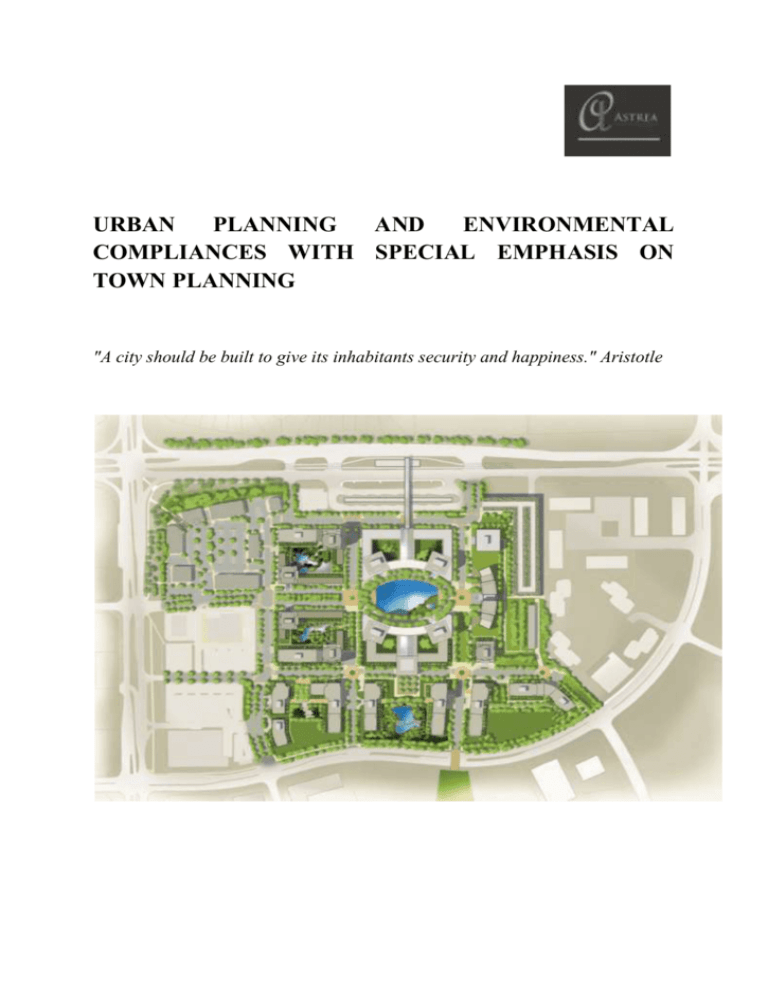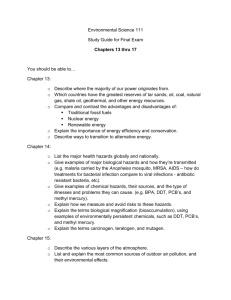urban planning and environmental compliances with
advertisement

URBAN PLANNING AND ENVIRONMENTAL COMPLIANCES WITH SPECIAL EMPHASIS ON TOWN PLANNING "A city should be built to give its inhabitants security and happiness." Aristotle INTRODUCTION What is urban planning? Urban planning is design and regulation of the uses of space that focus on the physical form, economic functions, and social impacts of the urban environment and of different activities within it. Because urban planning draws upon engineering, architectural, and social and political concerns, it is variously a technical profession. Basically, Urban planning (urban, merged urban regions, regional, city, and town planning) is a technical and political process concerned with the use of land and design of the urban environment, including air and water and infrastructure passing into and out of urban areas such as transportation and distribution networks. Urban planning concerns itself with both the development of open land and the revitalization of existing parts of the city, thereby involving goal setting, data collection and analysis, forecasting, design, strategic thinking, and public consultation. The modern origins of urban planning lie in the movement for urban reform that arose as a reaction against the disorder of the industrial city in the mid-19th century. What is town planning? The science of ordering the use of land so as to secure maximum practicable degree of economy, convenience and beauty. It is the art of shaping and directing the physical growth of town creating buildings and environments to meet the different needs of people such as social, cultural, economic and recreational etc. The aim of town planning is to ensure rational use of land, well balanced social and economic development, judicious use of resources, environmental protection and improvement of quality of life. What is sustainable development and sustainability? Sustainable development and sustainability influence today's urban planners. Some planners argue that modern lifestyles use too many natural resources, polluting or destroying ecosystems, increasing social inequality, creating urban heat islands, and causing climate change. Many urban planners, therefore, advocate sustainable cities. Urban planners, including town planners, are now promoting a sustainable city model, which consists of cities that designed with consideration of environmental impacts, such as minimizing the uses of energy, water, and the outputs of waste and pollution. However, actual implementation is often a complex. With the increase in awareness about sustainable development, the rules for giving permits to large infrastructural development projects have also become more stringent. Apart from the national rules, there are also state specific guidelines for these projects. Need of urban planning Demographic facts: About 377 million Indians comprising of about 31 per cent of the country’s population, live in urban areas according to Census 2011. Projections are that by 2031, about 600 million Indians will reside in urban areas, an increase of over 200 million in just 20 years. There is a concentration of the urban population in large cities and existing urban agglomerations. As per census 2011, there are 53 million plus cities accounting for about 43 per cent of India’s urban population. Census 2011 notes that the number of towns in India increased from 5,161 in 2001 to as many as 7935 in 2011 and the number is expected to further increase in the years to come. Needless to say that the coming years will witness the birth and expansion of many infrastructural projects; especially, township projects. Thus, for all this to happen, proper planning is an essential precondition. Problems of urban planning The above mentioned demographic facts clearly point out towards the need for better infrastructure and facilities in the urban areas. However, our Urban Local Bodies are unable to meet the growing demand and supply of the urban infrastructural services. The major factors responsible for deficiencies and constraints in delivery of services include increasing population, lack of fiscal autonomy, narrow tax base, poor maintenance of existing infrastructure, lack of professionalism and modernization at the local level, absence of institutional framework for the greater involvement of private sector, NGOs, community and bottlenecks in the mobilization of institutional finances. The responsibilities of town planning have now been entrusted to the ULB's th after 74 Constitutional Amendment. Town and Country Planning Organisation (TCPO) in the Urban Development Department at state level need to be strengthened. Also a need is felt of establishing similar Urban Local Bodies level and also at regional level. A CLOSER LOOK AT ENVIRONMENTAL LAWS IN INDIA The Environment [Protection] Act, 1986 POWER OF CENTRAL GOVERNMENT TO TAKE MEASURES TO PROTECT AND IMPROVE THE ENVIRONMENT This act provides several provisions regarding protection and improvement of quality of the environment and preventing controlling and abating environmental pollution. These measures include co-ordination of actions by the State Governments, officers and other authorities; planning and execution of a nation-wide programme for the prevention, control and abatement of environmental pollution; laying down standards for the quality of environment in its various aspects; laying down standards for emission or discharge of environmental pollutants from various sources. In view of the stringent provisions under the act , it is important to address different standards for emission, quality or composition of the emission or discharge of environmental pollutants from such sources. The Act also lays down restriction of areas in which any industries, operations or processes or class of industries, operations or processes shall not be carried out or shall be carried out subject to certain safeguards which include examination of manufacturing processes, materials and substances as are likely to cause environmental pollution; inspection of any premises, plant, equipment, machinery, manufacturing or other processes, materials or substances and giving, by order, of such directions to such authorities, officers or persons as it may consider necessary to take steps for the prevention, control and abatement of environmental pollution. Notwithstanding anything contained in any other law but subject to the provisions of this Act, the Central Government may, in the exercise of its powers and performance of its functions under this Act, issue directions in writing to any person, officer or any authority and such person, officer or authority shall be bound to comply with such directions. Such directions include the closure, prohibition or regulation of any industry, operation or process; or stoppage or regulation of the supply of electricity or water or any other service. It is necessary for the project owner of companies to conduct environmental law clearance/ audit of all potential projects with respect to; (a) the standards of quality of air, water or soil for various areas and purposes. (b) the maximum allowable limits of concentration of various environmental pollutants (including noise) for different areas; (c) the procedures and safeguards for the handling of hazardous substances; (d) the prohibition and restrictions on the handling of hazardous substances in different areas; (e) the prohibition and restriction on the location of industries and the carrying on process and operations in different areas; (f) the procedures and safeguards for the prevention of accidents which may cause environmental pollution and for providing for remedial measures for such accidents. CONSENT, PERMISSIONS CONTROL BOARD AND LICENSES BY POLLUTION Any industry, operation or process or an extension and addition thereto, which is likely to discharge sewerage or trade any effluent into the environment or likely to emit any air pollution into the atmosphere will have to obtain consent of the State Pollution Control Board under the provisions of Water (P & CP) Act, 1974 and Air (P & CP) Act, 1981. Similarly any industry / process generating, storing, transporting, disposing or handling hazardous waste as defined in schedule 1 and 2 of Hazardous waste (Handing and Management) Rules, 1989, as amended in 2000 are required to obtain authorization from MPC Board under the said rules. The MPCB's No Objection Certificate in the form of combined Consent to establishment under Water Act, Air Act & Hazardous wastes Rules would be required for setting up of an industrial unit. In regard to 39 specified industrial and infrastructure projects, environmental clearance from the Ministry of Environment and Forests, Govt. of India and State Environment Department are also required as per Environmental Impact Assessment Notification. CONCLUSION Overall, most bodies of pollution control and environmental protection grant licenses, permissions and consent to any infrastructural development project, including town planning projects which is not inconsistent with the Water [Prevention and control of Pollution] Act [1974], Air [Prevention and control of Pollution] Act [1981] and Hazardous Waste[M, H & T M] Rule [2008]. Apart from these there are area-wise specifications and guidelines which are to be followed while initiating in any development project in those areas. Prem Prateek Bhushan







